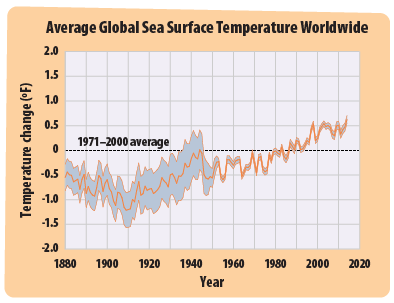Warmer Oceans
 The atmosphere affects oceans, and oceans influence the atmosphere. As the temperature of the air rises, oceans absorb some of this heat and also become warmer.
The atmosphere affects oceans, and oceans influence the atmosphere. As the temperature of the air rises, oceans absorb some of this heat and also become warmer.
What's happening now?

The surface of the world's oceans has become warmer overall since 1880. In this graph, the shaded band shows the likely temperature range, which depends on the number of measurements and the methods used at different times. Source: EPA's Climate Change Indicators (2016).
Overall, the world's oceans are warmer now than at any point in the last 50 years. The change is most obvious in the top layer of the ocean, which has grown much warmer since the late 1800s. This top layer is now getting warmer at a rate of 0.2°F per decade.
What will happen in the future?
Oceans are expected to continue getting warmer—both in the top layer and in deeper waters. Even if people stop adding extra greenhouse gases to the atmosphere now, oceans will continue to get warmer for many years as they slowly absorb extra heat from the atmosphere.
Why does it matter?
Warmer oceans affect weather patterns, cause more powerful tropical storms, and can impact many kinds of sea life, such as corals and fish. Warmer oceans are also one of the main causes of rising sea level.
Check out the major effects of warmer oceans on people and the environment:
Learn more about warmer oceans and sea level rise by going on an expedition to the Maldives!